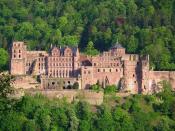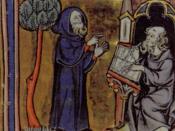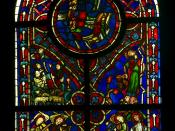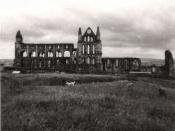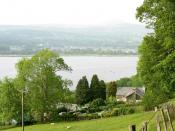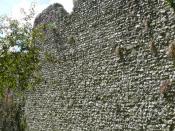Medieval Times Art and Entertainment This report is on the interesting topic of the arts and entertainment of people in the Middle Ages. There are so many facts and information on this time period, so I have written this detailed report on this topic. Art, music and entertainment were a critical and very important aspect of medieval life. Back in those times there were not nearly as many sources of entertainment as compared with the current day entertainment. They had no electricity so obviously they had none of the current day luxuries of television, video games, and other things we use today. Singing without using musical instruments was an essential and important part of church services. A few of the churches had some instruments including the organ and bells. Some churches also had a symphony, which was later known as the hurdy gurdy. This instrument required two players because one of the players had to turn the crank while the other played the keys.
When people think of these times they tend to think of knights in shining armor, monks, bishops, queens, kings, and glorious pagaentry. In many movies and other sources of information, the lives of these people seems to be very heroic, and entertaining. These times may have been times of great action and excitement but at the same time they were also harsh an uncertain times. This time period extended from the fifth century to the fifteenth century.
The Middle Ages were basically situated in Western Europe. The time I'll be writing about is around 1290. For defense and protection, people in the "Middle Ages formed small communities around a central lord or master"ÃÂ (www.learner.org/exhibits/middleages/feudal.html). Many of the people in this time lived upon a manor, which consisted of a church, the castle, the village, and of course the surrounding farm land. In the "feudal" system, the king usually awarded land grants to his more important and wealthy nobles, barons, and bishops. To receive this "fiefs" they must give the king soldiers for his armies. The lowest and most poor people in society were the peasants. They were called "serfs"; they worked in exchange for protection from the lord. In the following paragraphs I will be writing about the entertainment aspects of everyday feudal life. Some of the topics will include fishing, braid weaving, minstrels and jesters, pottery, wood working, and hunting.
The consumption and catching of fish in the early medieval period of time was an important aspect of everyday life as well as entertainment. ;According to Bede, Bishop Winfid of Colchester county '...found so much misery from hunger he taught the people to get food by fishing. For, although there was plenty of fish in the seas and rivers, the people had no idea about fishing, and only caught eels. So the bishop's men got together eel nets from all sides and threw them into the sea. By God's help they caught three hundred fish of all kinds."(www.regia.org/fishing.htm). The majority of the evidence that links to the fact that they fished back in these time periods as a source of entertainment comes from soil excavations. As with today, the seas were a rich and vital source of both food and fish as well as shellfish. Occasionally they caught porpoises and whales. They used lures, fishing spears, and other ways to catch sealife including an eel spear, which has a pointy, barbed side to get a better grip of the fish.
Another popular thing to do in these times was braid weaving to pass time and decorate. There are many different ways of weaving narrow fabrics for items such as girdles, leg bindings, decorative braids, and borders. The different techniques of making braids was what made it such a difficult yet interesting hobby or job. Tablet weaving is one of the oldest European textile techniques; this way of weaving is traceable back to at least the Iron Age. By varying the colors of the yarn and the way that the tablet turn, unique and intricate warp patterns can be made. Another method in which braids could be produced is called inkle weaving. Different materials that have been found in braids are wool, linen and silk. "The number of patterns possible are almost limitless"(www.regina.org/braids.htm).
As many of you know, minstrels and jesters were a very popular source of entertainment in these times. Minstrels provided a form of entertainment for the upper class as well as the peasants. "They sang and played songs telling of great battles, honor and chivalry, myths like the story of King Arthur, and of course love" (http://library.thinkquest.org/10949/fief/hientertain.html?tqsip=1). The unique and interesting part about minstrels was the fact that they knew how to play many different instruments. The more popular instruments included a harp or a flute. While the more rare instruments were anything from a guitar to a bagpipe. Most of these minstrels were traveling, most of the time they wandered wherever they pleased. In rare occasions, a minstrel would be stuck with one person for a long period of time, for example the king. The minstrel would expect to be fed and perhaps even given gift of clothes. Jesters usually enjoyed a more sedentary life than the minstrel did. Jesters preferred not going from place to place and instead staying stationary in one castle serving the same king for long periods of time. The jester's job was a rather simple one seeing as though his only task was to make his master laugh. They tended to wear funny clothes with bright colors or bells dangling from their hat. The majority of jesters performed tricks such as juggling or acrobats. They were expected to be quite funny with words as they twisted them around to make jokes or hilarious puns.
The British Isles had large areas of clay that were incredibly suitable for making pottery. Pottery was a cheap and an important way to make cooking pots, cups, bowls,, bottles, and jugs. "In early pagan Anglo-Saxon times pottery "ÃÂurns' were used to hold the ashes of people who died and were cremated"ÃÂ(www.regia.org/pottery.htm). There were specialist potters who made different types of pottery on wheels inside of the village. The pots were used for a variety of purposes, including cooking, storage, and some for eating and drinking out of. Many of the bowls were used for cooking as well as storage. There were many different types of pottery. Chester type was a sandy brown, wheel thrown pottery. The Chester pots have a unique flanged rim around the top. There are many other types of pottery as well including Fine Whitby, Leicaster ware, Lincoln type and Michelmersh ware just to name a few.
Woodworking was by far one of the most important skills and resources of this time period. The medieval carpenter was skilled with working with wood but also knew how to pick out the correct type of wood for the certain job. Most tools had wooden handles. Rakes and spades were also made from timber. Another form of woodworking was basket weaving. This was done with small thin strips of fine wood and bark. Many of the current terms for basket weaving used today are from the Old English.
Hunting was also a major aspect of Medieval times. It was a very popular pastime in the middle ages. Not only knights liked to hunt but many peasants also enjoyed it. Forests were used as the common hunting ground. Knights hunted deer, foxes, rabbits, wolves, and boars. Hunting was also known as a favorite sport, although it was illegal many people still hunted for fun and a hobby. Some of the weapons that knights used as a source of attacking are rondel, lance, thrusting sword, horseman's axe, a mace, and even a poleax. A knight's sword usually weighed somewhere around 2 and a half pounds.
As I was reading the book "Catherine Called Birdy"ÃÂ I learned a lot about the lifestyles of people in the Middle Ages. I also found out through obvious pieces of information that Catherine was a feminist to the fullest extent. According to Websters 9th Collegiate dictionary a feminist is a woman who believes in "political, economic, and social equality of the sexes"ÃÂ. She makes many very obvious statements regarding the fact that she is most definitely a feminist. There is a list of the things that girls are not allowed to do. The list looks something like this- "go on crusade, be horse trainers, be monks, laugh very loud, wear breeches, drink in ale houses, cut their hair, piss in the fire to make it hiss, wear nothing, be alone, get sunburned, run, marry whom they will, glide on the ice"ÃÂ (Cushman pg. 83-84). Also throughout a large portion of the book she complains about the constant troubles and arguments she has with her father. She states that she hates him numerous times by using the phrase "may the devil take him"ÃÂ. Obviously there is clear proof she has something against the male is general. I think the relationship that she had with her father growing up may have had a huge influence and effect upon how she thinks of men.
